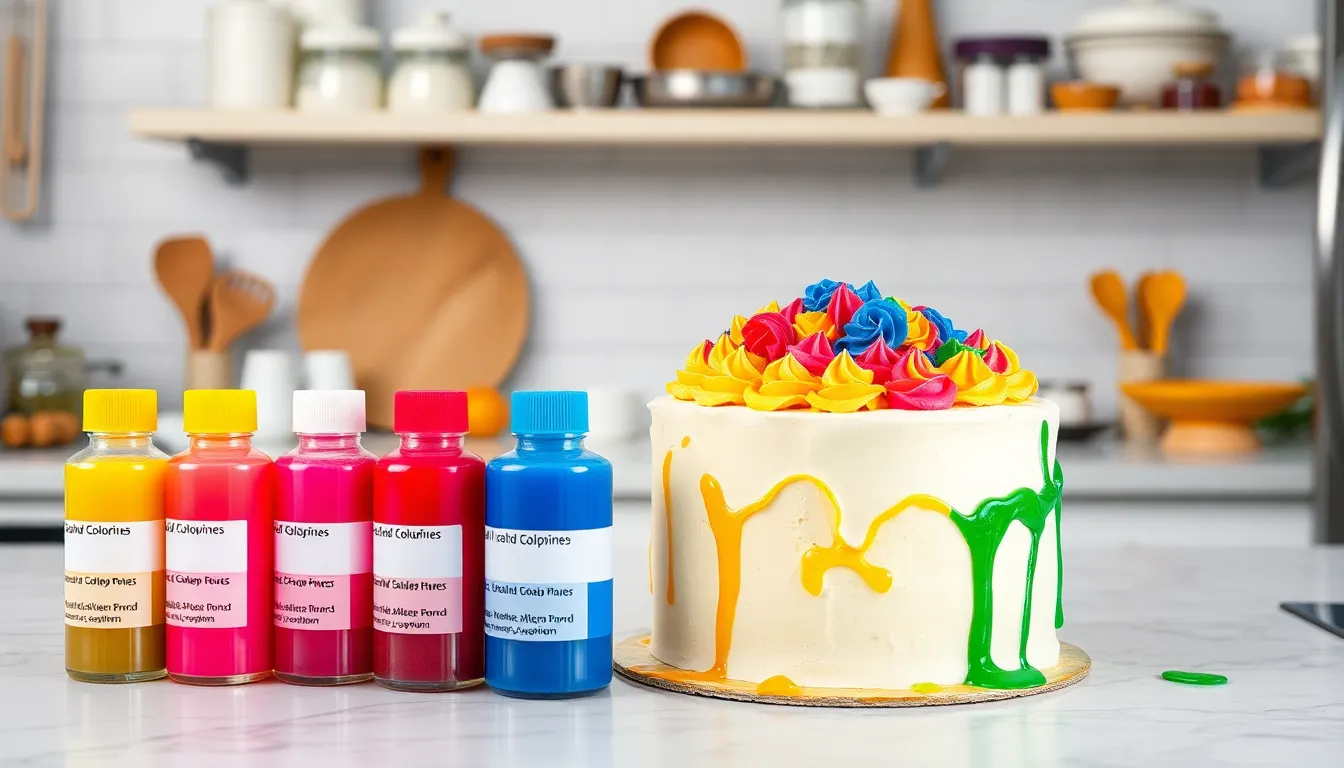Last Updated on September 21, 2025 by Nala Thorpe
Imagine a world where your culinary creations burst with vibrant colors that make your taste buds dance. Enter oil food coloring—the unsung hero of the kitchen that transforms ordinary dishes into extraordinary masterpieces. Whether it’s a cake that looks like a rainbow exploded or a savory dish that dazzles the eyes, oil food coloring is here to elevate every meal.Oil Food Coloring
Oil food coloring consists of coloring agents suspended in an oil base. This formulation allows the dye to blend seamlessly into oil-based products. Chefs and bakers often prefer oil food coloring over conventional water-based dyes for certain applications. Versatile in use, oil food coloring works well in various recipes. Candy making benefits from this type of coloring, as it maintains stability at high temperatures. It also enhances frosting and buttercream, creating visually appealing decorations. Oil food coloring presents unique advantages compared to traditional food colors. One significant benefit involves its ability to maintain color integrity when mixed with fat. This characteristic proves essential for achieving the desired shade in baked goods and confections. When selecting oil food coloring, pay attention to the variety and strength. Many brands offer vibrant options that provide different hues. Knowing how to determine the correct amount needed will lead to optimal results. In addition to baking, oil food coloring serves well in savory dishes. Adding vibrant colors to sauces and marinades elevates presentation. Chefs should consider using it to enhance rich dishes, establishing an appealing visual contrast. Oil food coloring serves as a key ingredient for both aesthetic and practical purposes in culinary applications. Choosing the right product contributes significantly to the overall quality and appeal of various dishes.Benefits of Using Oil Food Coloring

Enhanced Vibrancy
Enhanced vibrancy stands out as a key benefit of oil food coloring. Chefs use it to achieve rich and vivid colors that capture attention. When mixed with buttercream or frosting, colors maintain their intensity, making desserts visually striking. Specific brands offer a wide color palette, allowing for creative freedom in food design. Vibrant colors can transform a simple cake into an eye-catching centerpiece. Diners often respond more positively to visually appealing dishes, making this aspect crucial for culinary success.Stability in High Temperatures
Stability in high temperatures represents another significant advantage. Oil food coloring retains its color even when exposed to heat. Baking at elevated temperatures poses a challenge for many colorants, but oil-based options withstand this without fading. This stability is particularly important for candy making and baked goods that require precise color retention. The consistent hues provided by oil food coloring contribute to the overall quality of dishes, ensuring they maintain their visual appeal from oven to table. Chefs value this reliability, especially in high-stakes culinary environments.How to Use Oil Food Coloring
Utilizing oil food coloring effectively enhances both visual appeal and flavor. Understanding proper techniques ensures optimal results in culinary applications.Mixing Techniques
Mixing oil food coloring requires precision. Start by pouring the desired amount of oil coloring into a small mixing bowl. Gradually add the oil-based ingredient, such as melted chocolate or frosting. Stir thoroughly until a uniform color appears. Adjust the hue by adding small amounts of coloring, knowing that oil-based colors are concentrated. Using a toothpick or pipette for small adjustments maintains control over the shade consistency. Thorough mixing ensures even distribution, resulting in vivid color throughout the mixture.Application Methods
Applying oil food coloring can vary based on the intended use. For frosting or buttercream, use a spatula to spread color evenly. Inject colors into confections with a piping bag for precise detailing. When coloring sauces, whisk in the oil food coloring slowly to avoid clumps. For baked goods, brush or drizzle the color on top to achieve eye-catching effects. Exploring different tools allows for creativity and customization, showcasing culinary skills effectively. Using oil food coloring introduces an exciting element to every dish.Popular Brands of Oil Food Coloring
Numerous brands excel in producing high-quality oil food coloring. Each brand boasts unique offerings that appeal to various culinary needs.-
- Wilton: Known for its extensive range of cake decorating products, Wilton provides vibrant oil food colors that blend seamlessly into frostings and batters.
-
- Chefmaster: This brand specializes in professional-grade food coloring. Chefmaster’s oil-based options are widely used by bakers for candy-making projects, ensuring excellent color retention.
-
- AmeriColor: Renowned for its innovative products, AmeriColor offers oil food colors that guarantee consistent results. Chefs favor these colors for their intensity and ease of use.
-
- ** icingimages**: This brand focuses on providing high-quality, concentrated oil food colors perfect for chocolate decorations. Icingimages’ products maintain color integrity even in demanding applications.
-
- LorAnn: Specializing in concentrated flavors and colors, LorAnn’s oil food coloring is highly regarded among confectioners. The brand’s vibrant colors enhance the appeal of candies and baked goods.
-
- Colors by Rosie: This brand emphasizes natural ingredients in its oil food coloring. Colors by Rosie offers a variety of vibrant shades, appealing to those who prefer cleaner labels.
-
- Satin Ice: Known for high-quality fondant, Satin Ice also manufactures oil-based colors specifically designed for use in modeling chocolate and buttercream. The brand’s products deliver rich and vivid hues.



